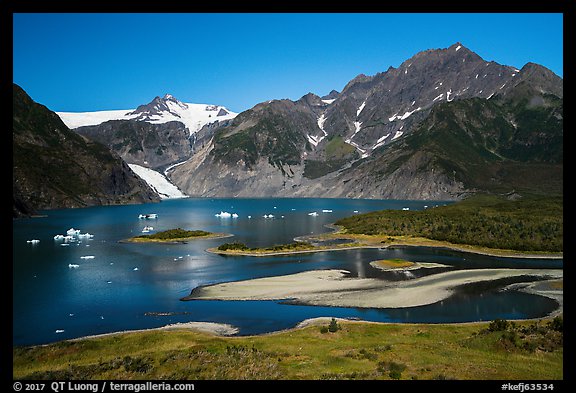Kenai Fjords National Park by Helicopter
No Comments
In Alaska, because of the size of the land and the limited number of roads, much of backcountry access is by small plane. I have made aerial photographs in each of the Alaskan national parks. However, when planning an aerial session in Kenai Fjords National Park, it was exciting to notice that helicopter flights have become available there.

This is possible because Seward is a sizeable community by Alaska standards, and located a short distance from the national park. Kenai Fjords National Park packs such a diversity of scenery in a relatively small area that you could see a lot even on a half-hour aerial tour: mountains, glaciers, the fjords and lagoons, and icebergs. We extended our tour to one hour, which allowed us to reach places such as Pedersen Lagoon which has all of the above in single spot.
Compared to airplanes, helicopters have several advantages for aerial photography. The available range of speeds varies from hovering in a stationary position to speeds comparable to airplanes when you need to cover distances to get somewhere. They can fly at very low elevations, providing a stronger perspective since the foreground is much closer than the background. You could even land in many places, although not in the national park. The main drawback is that the charter cost, even with a relatively low-cost helicopter such as the popular Robinson R44, is still double that of a fixed-wing aircraft.
The Robinson R44 doesn’t have a sliding window, but our pilot, the excellent Mike Culver of Marathon Helicopters graciously agreed to remove the doors, a practice uncommon in Alaska! When you fly in a helicopter with doors removed, you have to make sure not to have anything loose in the cockpit, as turbulence could cause objects to get blown out the door and into the tail rotor. The tail rotor is the most fragile part of the helicopter and is critical to prevent uncontrolled spinning of the aircraft. I carried two cameras constantly strapped to me, one with a 16-35mm lens, the other with a 24-70mm lens, and kept spare batteries in my pockets.
Mike had told me that if I wished, I could lean out of the door to photograph, but when I tried to do so, the wind was unbelievably strong and I could barely hold the camera which was vibrating like crazy. For the rest of the flight, I made sure to not even stick the lens barrel out. Yet, with the doors removed, the back of the helicopter was still one of the windiest places I have ever experienced. Shutter speeds of at least 1/1000s were necessary to ensure photos were not blurred. Although I wore tops and bottom windbreaker fabric, I breathed a bit of relief when the flight ended and the wind stopped.
We had planned to take the flight in the early morning, but at that time the winds were too high. They would cause turbulences that make it unsafe to fly low. It was the only clear day of our trip, so we took off in the late morning. At that time of the day, even at those northern latitudes and in September, the sun was quite a bit higher than ideal, resulting in rather flat front light and side light. I mitigated the problem by shooting often slightly or entirely backlit, which increased the contrast and created a shimmering effect on the water. The window would have caused flare, so removing it was worth it!







Autumn in Alaska: Part 5 of 9: 1 | 2 | 3 | 4 | 5 | 6 | 7 | 8 | 9

